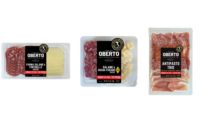The global market for meat snacks is projected to reach more than $14 billion by 2027 as consumers seeking convenient and healthy snacking options embrace innovative flavors incorporating unique proteins and ingredients.
More than two-thirds (67%) of consumers say they are increasingly snacking just for the eating pleasure and not to satisfy their hunger, according to IRI consumer research, and just more than half (51%) say they are looking for authentic or unique snack experiences.
These adventurous, pleasure-seeking shoppers are increasingly losing their appetite for impulse buying, however, with more than a quarter (28%) saying they have reduced their snack purchases.
In a category that boasts ever-increasing competition from relative upstarts like plant-based protein snacks finding their niche alongside the ever-increasing diversity of offerings from marketers of meat-based protein snacks, some marketers see the competitive advantage of meat snacks as just that — they’re snacks made with meat, “real food” contrasted with what consumers may consider more heavily processed snack alternatives.
“Real smokehouses use real smoke — not liquid or artificial smoke,” said Michael Schafer, Commercial Business Lead for Vermont Smoke & Cure, which has marketed smoked meat mini stick products since 2016, using ground corn cob, hickory and maple wood shavings to smoke the meat sticks.
The Power of Meat 2022 study found that sales for plant-based meat alternatives plateaued mid-year in 2021 and backslid in the third and fourth quarters, with only 9% eating plant-based meat alternatives weekly.
“When you consider other protein snack options like protein bars, shakes, and protein chips, they are much more processed items,” said Country Archer Provisions Vice President of Marketing Jeff Wong. “While consumers may be OK eating these every once in a while, ultimately consumers crave just natural options with ingredients they can recognize.”
Wong said the market has shifted over the years, and more consumers are open to innovative meat snacks.
“While the category continues to grow, the better-for-you segment is outpacing the conventional,” he said. “We believe better-for-you will continue to accelerate. This will bring additional opportunities, consumers and purchasing habits to the table for us to explore.”
Given the current challenging business climate, successful product rollouts favor marketers that are innovative and flexible.
“The supply chain, inflation, and I would add labor issues, have been real, not just in terms of raw materials, but also as a vertically integrated business, where we have an entire manufacturing labor workforce to manage,” Wong said. “We’ve definitely had to think about and act on creating available capacity, reducing supply chain complexity and increasing retail pricing as a result of all these challenges.”
He added, “Luckily, again, our vertical integration helped us, as we were able to get ahead of many of the factors that slowed or shut down other processors, and keep at least some of the control to these variables within our own hands.”
Schafer said the ongoing trend of value-minded consumers looking to save by buying their favorite snacks in bulk lead Vermont Smoke & Cure to roll out eight-count cases of their .5-ounce pouches as well as 96- and 192-count bulk packaged options.

.png?height=96&t=1647275041&width=96)



